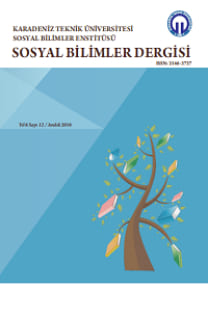TÜRKİYE'DE GELİR DAĞILIMININ SOSYO EKONOMİK PROFİLİ
Bu çalışmanın amacı 2002 yılından bu yana Türkiye'de gerçekleşen ekonomik büyüme ve refah artışının farklı sosyo-ekonomik profile sahip hanehalkları arasında nasıl dağıldığını analiz etmektir. Bu amaçla Türkiye'de yerleşik hanehalklarına uygulanan Hanehalkı Bütçe Anketi verilerinden yararlanılarak 2003-2012 yılları için gelir eşitsizliği, hanehalkı reisine ait eğitim, yaş, cinsiyet, meslek kolu, iktisadi faaliyet kolu, yerleşim yeri gibi sosyo-ekonomik değişkenlerine göre alt gruplara ayrıştırılarak Theil endeksleri hesaplanmıştır. Bu sayede ilgili dönem için gelir eşitsizliğinin, oluşturulan bu alt gruplar içindeki ve arasındaki seyri de gözlemlenebilmiştir. Çalışmadan elde edilen en önemli bulgulardan birincisi cinsiyetler arası eşitsizliğin azaltılmasının toplam eşitsizliği azaltmada hiçbir rolünün olmadığı, ikincisi ise gayrimenkul, kiralama ve iş faaliyetlerinden gelir elde eden hanehalklarının grup içi gelir eşitsizliğinin en yüksek grup olduğudur.
SOCIO-ECONOMIC PROFILE OF INCOME DISTRIBUTION IN TURKEY
The aim of this study is to analyze the distribution of economic growth and welfare increase that have been performing in Turkey since 2002 among households with different socio-economic profile. For this purpose, the income inequality is decomposed by subgroups according to head of household's demographic variables such as education level, age, gender, occupation, working sector, and living area by calculating the Theil index using the 2003-2012 Household Budget Survey data conducted on resident households in Turkey. Thus the pattern of the income inequality between and within these subgroups could be observed during the corresponding term. The first main findings obtained from this study is that there is no role of the decreasing inequality between male and female on reducing the overall inequality, second is that households earning income from real estate, rental, and business activities is the highest group having income inequality within the group.
___
- Atkinson, A.B., (1993). What is Happening to the Distribution of Income in the UK?, Proceedings of the British Academy, 82, 317-351.
- Aydın, K., (2012). Türkiye'de Kişisel Gelir Dağılımının Sosyo Ekonomik ve Demografik Belirleyicileri, Çalışma ve Toplum 2012(1), 147-166.
- Brandolini, A., & D'Alessio, G., (2001). Household Structure and Income Inequality, Ceps/Instead-Centre D'etudes De Populations, De Pauvrete Et De Politiques Socio-Economiques/ International Networks for Studies in Technology, Environment, Alternatives, Development.
- Bourguignon, F., (1979). Decomposable Income Inequality Measures, Econometrica, 47(4), 901-920.
- Breen, R., García-Peñalosa, C., Orgiazzi, E., (2008). Factor Components of Inequality: CrossCountry Differences and Time Changes, Luxembourg Income Study, Working Paper Series, (503).
- Conceição, P., & Ferreira, P., (2000). The Young Person's Guide to the Theil Index: Suggesting Intuitive Interpretations and Exploring Analytical Applications, UTIP Working Paper No. 14.
- Cowell, F., (1980). On the Structure of Additive Inequality Measures, The Review of Economic Studies, 47(3), 521-531.
- Cowell, F., & Jenkins, S., (1995). How Much Inequality Can We Explain? a Methodology and an Application to the United States, The Economic Journal, 105(429), 421-430.
- Cowell, F., & Kuga, K., (1981). Additivity and the Entropy Concept: an Axiomatic Approach to Inequality Measurement, Journal of Economic Theory, 25(1), 131-143.
- Dagum, C. (1998). A New Approach to the Decomposition of the Gini Income Inequality Ratio, içinde Income Inequality, Poverty, and Economic Welfare, 47-63, Physica-Verlag HD.
- Dollar, D. & Glewwe, P. & Lıtvack, J. I., (1998). içinde Household Welfare and Vietnam's Transition, World Bank Publications.
- Eksi, O., & Kırdar, M. G., (2015). Emek Gelirlerinin ve Eşitsizliğinin Türkiye için bir Analizi: 2002-2011, Turkish Economic Association, Discussion Paper 2015/2.
- Gürler, Ö. K., & Üçdoğruk, Ş., (2007). Türkiye'de Cinsiyete Göre Gelir Farklılığının Ayrıştırma Yöntemiyle Uygulanması, Journal of Yaşar University, 2(6), 571-588.
- Jenkins, S. P., (1995). Accounting for Inequality Trends: Decomposition Analyses for the UK, 1971-86, Economica, 29-63.
- Kaya E., & Şenesen, Ü., (2011). Türkiye'de Gelir Bölüşümü Eşitsizliğine Cinsiyet Ayrımının Katkısı, Atatürk Üniversitesi İktisadi ve İdari Bilimler Dergisi, 25.
- Kuştepeli, Y., & Halaç, A., (2004). Türkiye'de Genel Gelir Dağılımının Analizi ve İyileştirilmesi, Dokuz Eylül Üniversitesi Sosyal Bilimler Enstitüsü Dergisi, Cilt 6 Sayı 4: 143-160.
- Memiş, E. (2013). Deriving Macro Policy from Income Inequality Decompositions by Subgroups: A Cautionary Discussion. Ekonomik Yaklasim, 24(87), 69-84.
- Mookherjee, D., & Shorrocks, A., (1982). A Decomposition Analysis of the Trend in UK Income Inequality, The Economic Journal, 92(368), 886-902.
- Papatheodorou, C., (2000). Decomposing Inequality by Population Subgroups in Greece: Results and Policy Implications, Suntory and Toyota International Centres for Economics and Related Disciplines.
- Parker, S. C., (1999). The Inequality of Employment and Self-Employment Incomes: A Decomposition Analysis for the U.K., Review of Income and Wealth, 45: 263-274.
- Shorrocks, A., (1980). The Class of Additively Decomposable Inequality Measures, Econometrica, 48(3), 613-625.
- Shorrocks, A. (1984). Inequality Decomposition by Population Subgroups, Econometrica, 52(6), 1369-1385.
- TUİK (2003-2012). Hanehalkı Bütçe Anketi, Ankara.
- Tsakloglou, P., (1993). Aspects of Inequality in Greece: Measurement, Decomposition and Intertemporal Change: 1974-1982, Journal of Development Economics, 40(1), 53-74.
- ISSN: 2146-3727
- Yayın Aralığı: Yılda 2 Sayı
- Başlangıç: 2011
- Yayıncı: Karadeniz Teknik Üniversitesi Sosyal Bilimler Enstitüsü
Sayıdaki Diğer Makaleler
ALAIN TOURAINE'İN DEMOKRASİ DÜŞÜNCESİ ÜZERİNE BİR DEĞERLENDİRME
TÜRKİYE'DE GELİR DAĞILIMININ SOSYO EKONOMİK PROFİLİ
TRABZON'DA ENGELLİ KADIN PROFİLİ
Nezahat ALTUNTAŞ, Gülmelek DOĞANAY
OSMANLI DEVLETİ'NDE İHRACAT VE İTHALAT ARASINDAKİ UZUN DÖNEM İLİŞKİSİ: 1840-1913
Nebiye YAMAK, Rahmi YAMAK, Sinem KOÇAK
TÜRKİYE'DE ENFLASYON HEDEFLEMESİNİN MAKROEKONOMİK PERFORMANS ÜZERİNDEKİ ETKİLERİ
Bahar BURTAN DOĞAN, Zeki AKBAKAY
TÜRKİYE'DEKİ MUHASEBE ANLAYIŞININ GELİŞİM SÜRECİ VE MEVCUT DURUMUN İNCELENMESİ
